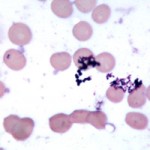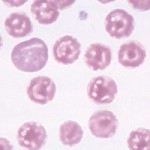Stain precipitate

Stain precipitate usually results from the use of aged staining solutions and/or inadequate rinsing of slides following application of stain.
Shown at right is a smear in which large obvious aggregates of stain precipitate are overlying erythrocytes. Notice how the precipitate is in a different plane of focus than are the cells. Finer precipitate can effectively mimic epicellular parasites or bacteria, and may obscure detail.
Water artifact

Water artifact when severe, results in a moth-eaten appearance to the cell. It is a refractile artifact that results from the presence of water in the fixative; it usually occurs when using poorly-maintained quick stains.
Refractile means that as one focuses up and down on the cell, the artifact “flashes”; in one plane of focus it may appear dark, while in another plane it appears bright. Such artifact is often mistaken for some form of erythrocyte inclusion, such as a parasite (e.g. Mycoplasma haemofelis).
Miscellaneous

Occasionally platelets can come to rest on top of erythrocytes in a blood film. Inexperienced observers have been known to mistake this combination of normal hemic elements for an erythroparasite.
Careful observation and comparison to “free” platelets will lead to the proper identification of this phenomenon.
